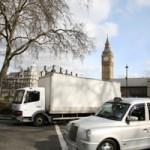Freight deliveries within the capital should be shifted outside of peak hours, according to a new report from the Roads Task Force (RTF).
In its vision for London’s roads and streets, the RTF called today for more investment in infrastructure, as well as greater use of technology to ease congestion through active management.
However, it also states that changing the way that goods are delivered is key, if the city is to continue functioning against the backdrop of expected population growth of 1.7 million to 10 million by 2031.
“Shifting LGVs and freight out of peak hours as seen during the London 2012 Games and switching deliveries to vans, biked or powered vehicles,” is one of 13 headline measures put forward in today’s report.
Mayor lends his support
In response, London Mayor Boris Johnson gave the “bold” work a warm welcome, citing that the key recommendations were broadly in-line with own 2020 Vision and plans for cycling in the capital.
Transport for London (TfL) has also welcomed RTF’s vision, but also pledged to work closely with the freight and logistics industry to ensure future proposals can best support the economy and functioning of a world city with a growing population.
“The RTF’s proposals include retiming freight outside peak hours to cut congestion and improve road safety, as well as air quality.
“They also include well planned and managed access for freight and deliveries

in central London, town centres and new developments to support businesses and local communities,” TfL said in a statement.
More flexibility needed
The FTA welcomed the overall findings of the report. Natalie Chapman, FTA’s head of policy for London, added: “Too many deliveries are forced into the morning peak, due to the constraints of night time delivery curfews. We need to make better use of London’s road space throughout the day and night.
“It is crucial that the boroughs work with industry to relax these restrictions and the time is right for a proper review of the London Lorry Control Scheme which restricts the movement of lorries overnight.”
Hugh Basham, director of transport strategy at DHL Supply Chain, said: “DHL welcomes today’s mayor’s Roads Task Force report, which highlights the importance of freight in delivering an improved transport network for London.
"The proposed investment in infrastructure and consideration of alternative transport modes and times will improve congestion and help navigate the challenges associated with London’s roads.
"The Olympics demonstrated the ability of London’s network to cope with change, and the opportunity for shared user dynamic lanes managed by new and advanced technology will play a major part in improving traffic flows.”
TfL plans to commence additional out of hours trials in challenging delivery areas within London this year, in a bid to build on the industry’s Olympics work around night time deliveries. The intention is to add to the existing portfolio of evidence that operators can deliver at night time without an onerous impact on local residents.
RTF Report recommendations
The RTF is an independent group set up by the mayor of London last July to study the challenges facing the capital's road network and suggest remedies.
In its report, it also called for studies on whether tolled road tunnels could replace surface capacity, which would include managed access for freight.
RTF makes 10 key key recommendations and forecasts that its vision would cost £30bn over 20 years to implement. Key points of the report are:
- Roofing over arterial roads to create new surface space, reconnecting severed communities, while providing for strategically important freight and business traffic;
- Changing the way goods and services are delivered;
- Embracing ‘next generation’ travel demand, to encourage a greater shift to more sustainable modes such as walking, cycling and powered two wheelers;
- Efficient road links and tackling junction ‘pinch points’, which will support businesses, including tradesmen and small businesses reliant on vans;
- Even greater use of intelligent systems and technology, to reduce delays at traffic signals, smooth traffic flows and provide road users with the best possible real-time information to help plan journeys;
- Enhanced road links and connectivity including new river crossings;
- Smarter charging for the use of road space, including tolling for new infrastructure;
- New capacity for sustainable modes, including bridges for walking and cycling and more dedicated lanes;
- More area-wide 20mph zones, to improve liveability and safety;
- High levels of accessibility across transport modes, including recognising the role of the car particularly in outer London;
- Good quality parking, for cars, bikes, Blue Badge holders and powered two wheelers;
- Village-style streets in new developments, with good access for buses, walking, cycling and freight and ‘car-lite’ development;














